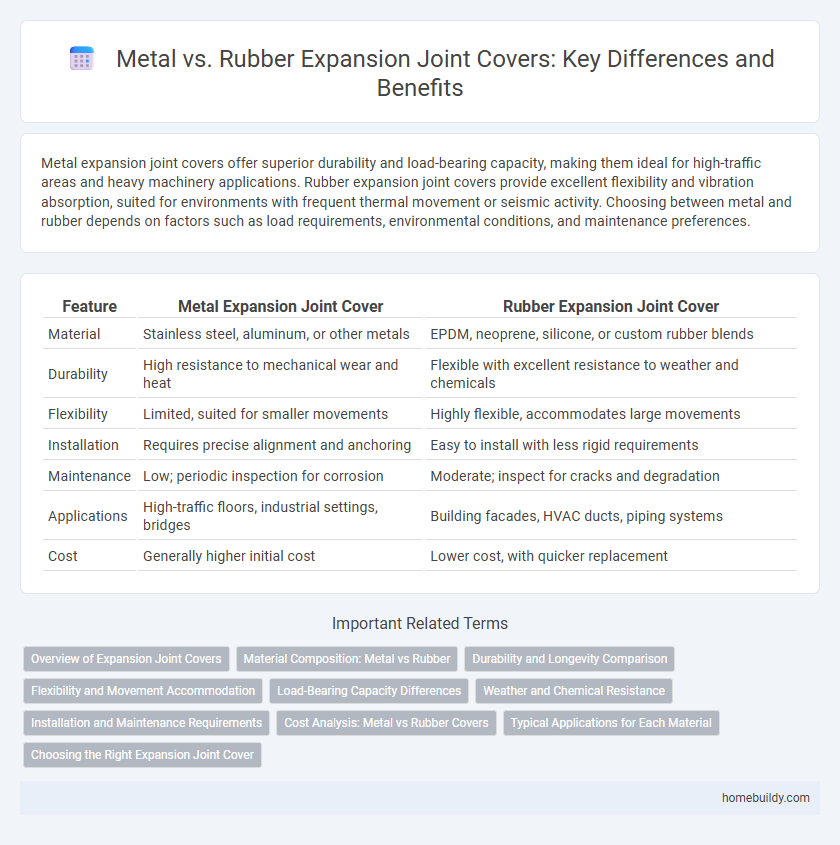Metal expansion joint covers offer superior durability and load-bearing capacity, making them ideal for high-traffic areas and heavy machinery applications. Rubber expansion joint covers provide excellent flexibility and vibration absorption, suited for environments with frequent thermal movement or seismic activity. Choosing between metal and rubber depends on factors such as load requirements, environmental conditions, and maintenance preferences.
Table of Comparison
| Feature | Metal Expansion Joint Cover | Rubber Expansion Joint Cover |
|---|---|---|
| Material | Stainless steel, aluminum, or other metals | EPDM, neoprene, silicone, or custom rubber blends |
| Durability | High resistance to mechanical wear and heat | Flexible with excellent resistance to weather and chemicals |
| Flexibility | Limited, suited for smaller movements | Highly flexible, accommodates large movements |
| Installation | Requires precise alignment and anchoring | Easy to install with less rigid requirements |
| Maintenance | Low; periodic inspection for corrosion | Moderate; inspect for cracks and degradation |
| Applications | High-traffic floors, industrial settings, bridges | Building facades, HVAC ducts, piping systems |
| Cost | Generally higher initial cost | Lower cost, with quicker replacement |
Overview of Expansion Joint Covers
Metal expansion joint covers provide superior durability and load-bearing capacity, making them ideal for high-traffic areas and harsh environmental conditions. Rubber expansion joint covers offer exceptional flexibility and vibration absorption, suitable for applications requiring movement accommodation and noise reduction. Both types are essential for maintaining structural integrity by compensating for thermal expansion, seismic activities, and building movements.
Material Composition: Metal vs Rubber
Metal expansion joint covers are typically composed of aluminum, stainless steel, or galvanized steel, providing high tensile strength, corrosion resistance, and durability in extreme temperature ranges. Rubber expansion joint covers consist of synthetic elastomers like EPDM, neoprene, or nitrile, offering superior flexibility, elasticity, and vibration absorption while resisting chemicals and ozone. The material composition directly impacts the expansion joint cover's performance, lifespan, and suitability for varying environmental conditions and mechanical stresses.
Durability and Longevity Comparison
Metal expansion joint covers offer superior durability due to their resistance to extreme temperatures, heavy loads, and abrasive environments, making them ideal for industrial applications. Rubber expansion joint covers provide excellent flexibility and vibration absorption but tend to degrade faster under UV exposure and chemical contact, limiting their lifespan. When prioritizing longevity, metal covers outperform rubber counterparts by maintaining structural integrity over extended service periods in harsh conditions.
Flexibility and Movement Accommodation
Metal expansion joint covers offer high durability but limited flexibility compared to rubber expansion joint covers, which excel in accommodating significant movement and vibration due to their elastic properties. Rubber joint covers adapt better to complex structural shifts and thermal expansion, making them ideal for dynamic environments requiring extensive flexibility. Metal covers suit applications with minimal movement and higher mechanical stress, while rubber covers provide superior performance in systems demanding continuous movement accommodation.
Load-Bearing Capacity Differences
Metal expansion joint covers offer significantly higher load-bearing capacity compared to rubber expansion joint covers, making them ideal for heavy traffic areas and industrial applications. Steel or aluminum metal covers can withstand loads exceeding several tons, ensuring durability under vehicular or equipment weight. In contrast, rubber covers provide flexibility and vibration absorption but are limited in load capacity, typically suited for pedestrian or light-duty uses.
Weather and Chemical Resistance
Metal expansion joint covers provide superior resistance to extreme weather conditions, including high temperatures, UV exposure, and heavy rain, making them ideal for outdoor and industrial applications. Rubber expansion joint covers excel in chemical resistance, effectively withstanding exposure to oils, solvents, and corrosive substances commonly found in chemical plants and laboratories. The choice between metal and rubber expansion joint covers depends on the specific environmental factors, prioritizing metal for weather durability and rubber for chemical resilience.
Installation and Maintenance Requirements
Metal expansion joint covers require precise alignment and anchoring during installation to accommodate structural movement and prevent damage, often needing specialized tools and expertise. Maintenance involves regular inspections for corrosion, tightening of fasteners, and potential refinishing to ensure durability and performance. Rubber expansion joint covers offer easier installation with flexible mounting options and typically require less complex maintenance, focusing on checking for wear, tear, and material degradation to maintain elasticity and sealing properties.
Cost Analysis: Metal vs Rubber Covers
Metal expansion joint covers generally have higher upfront costs due to material and fabrication expenses but offer greater longevity and lower maintenance costs over time. Rubber expansion joint covers are typically less expensive initially and provide excellent flexibility and vibration absorption, though they may require more frequent replacement and maintenance. Evaluating the total cost of ownership, including installation, durability, and maintenance, is essential when choosing between metal and rubber expansion joint covers.
Typical Applications for Each Material
Metal expansion joint covers are commonly used in industrial facilities, bridges, airports, and commercial buildings where high durability and resistance to heavy traffic, temperature extremes, and mechanical stresses are required. Rubber expansion joint covers are ideal for applications in HVAC systems, plumbing, and seismic zones due to their excellent flexibility, vibration absorption, and ability to accommodate movement and misalignment. Selecting the appropriate material depends on environmental conditions, load requirements, and the degree of movement expected in the joint.
Choosing the Right Expansion Joint Cover
Metal expansion joint covers offer superior durability and load-bearing capacity, ideal for heavy traffic areas and structural applications requiring long-term resilience. Rubber expansion joint covers provide excellent flexibility and vibration absorption, suitable for dynamic environments with thermal movement and seismic activity. Selecting the right expansion joint cover depends on factors like building type, movement accommodation, environmental exposure, and maintenance requirements to ensure optimal performance.
Metal expansion joint cover vs Rubber expansion joint cover Infographic

 homebuildy.com
homebuildy.com